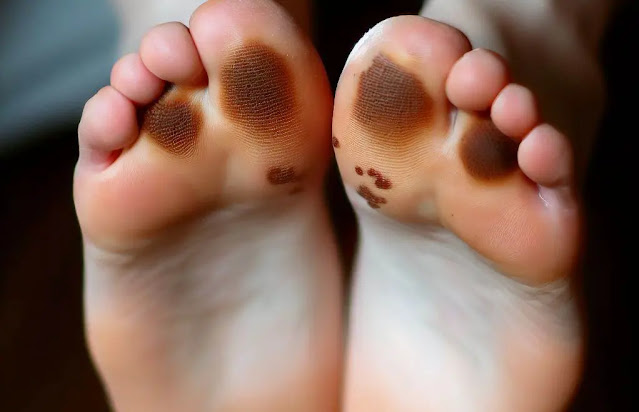Diabetes and brown spots on bottom of feet - Diabetes is a chronic condition characterized by high blood sugar levels that can have numerous effects on various parts of the body. While most people are aware of the potential complications that diabetes can have on organs such as the heart and kidneys, they may not realize that it can also lead to various skin problems. One particular skin concern that diabetics may experience is the presence of brown spots on the bottom of their feet. In this article, we will delve into the connection between diabetes and brown spots on the feet, exploring the causes, symptoms, and management strategies for these skin issues.
Diabetes, known as diabetes mellitus, is a metabolic disorder affecting the body's blood sugar processing. Individuals with diabetes often experience prolonged periods of high blood sugar, called hyperglycemia, which can lead to various health complications. One such complication involves the skin, as diabetes can impact its structure and function, making it more susceptible to a range of problems, including brown spots on the feet.
When blood sugar levels remain consistently high, it can damage the small blood vessels and nerves that supply the skin. This damage affects the skin's ability to receive proper nourishment and oxygen, leading to a compromised skin barrier. As a result, the skin becomes more prone to dryness, itching, and infection.
High blood sugar levels in diabetics can also impair the skin's ability to fight off infection and heal wounds effectively. This can lead to an increased risk of developing bacterial or fungal infections on the feet, especially in areas where moisture and warmth are more likely to be trapped, such as between the toes.
Additionally, high blood sugar levels can affect the production of collagen, a protein crucial for maintaining skin elasticity. As a result, diabetics may notice that their skin becomes thin, fragile, and prone to developing wounds or ulcers. These ulcers can be particularly problematic on the feet, as the pressure and friction from walking or wearing ill-fitting shoes can exacerbate the condition.
Common Skin Problems Associated with Diabetes
Diabetes can contribute to several skin problems, and brown spots on the bottom of the feet are one of the manifestations. These spots can vary in size and appearance, often resembling patches or discoloration on the skin. While multiple factors can contribute to the development of brown spots, one potential cause is persistently high blood sugar levels, especially a blood sugar stage of 200 mg/dL or greater.
In addition to the appearance of brown spots, diabetics may experience other symptoms such as itching, tingling, or a sensation of numbness in the affected areas. These symptoms can be indicative of peripheral neuropathy, a condition characterized by nerve damage that is commonly associated with diabetes. When the nerves in the feet are affected, it can lead to a loss of sensation or altered sensation, making it more challenging to detect injuries or ulcers.
Diabetic Dermopathy: The Connection to Brown Spots
Diabetic dermopathy, also recognized as shin spots, is a benign skin condition frequently found in individuals with long-standing diabetes. It is one specific skin condition commonly associated with diabetes and has the potential to contribute to the formation of brown spots on the feet.
Diabetic dermopathy typically presents as light brown or reddish-brown patches, often found on the lower legs and feet. These patches can appear slightly scaly and are usually painless. While the exact cause of diabetic dermopathy is not fully understood, it is believed to be associated with changes in blood vessels and damage to small nerves due to high blood sugar levels. Also, read diabetic dermopathy natural treatment.
It is important to note that the presence of diabetic dermopathy does not necessarily indicate poor diabetes control. Even individuals who effectively manage their blood sugar levels can develop this skin condition. However, it is more prevalent in individuals with a long history of diabetes or those with poorly controlled blood sugar levels.
To manage diabetic dermopathy, it is crucial to keep blood sugar levels under control through medication, lifestyle modifications, and dietary changes. Maintaining stable blood sugar levels can help reduce the risk of further skin complications and minimize the progression of diabetic dermopathy. Proper wound care and regular monitoring are also vital to prevent complications and promote healing.
Granuloma Annulare: Another Culprit of Brown Spots
In addition to diabetic dermopathy, another skin condition that may contribute to the development of brown spots on the bottom of the feet in diabetics is granuloma annulare. Granuloma annulare is a chronic skin disorder characterized by raised, ring-shaped bumps or lesions that can vary in size.
Although the exact cause of granuloma annulare is unknown, studies have suggested a potential link between this skin condition and diabetes. It is believed that high blood sugar levels and immune system dysfunction may play a role in the development of granuloma annulare, particularly in individuals with pre-existing diabetes.
If granuloma annulare is suspected, a dermatologist can provide a definitive diagnosis through a physical examination or skin biopsy. Treatment options for granuloma annulare vary but may include topical corticosteroids, cryotherapy (freezing the lesions), or light therapy, depending on the severity and location of the lesions.
Managing and Preventing Brown Spots on the Bottom of Feet
To manage and prevent brown spots on the bottom of the feet, it is essential for diabetics to prioritize their overall foot care. By taking proactive measures, individuals with diabetes can reduce the risk of developing skin problems and maintain optimal foot health. Also, read black spot on bottom of foot diabetes
One of the most critical aspects of managing brown spots on the bottom of the feet is maintaining stable blood sugar levels. This can be achieved through a combination of medication, dietary adjustments, regular physical activity, and close monitoring of blood glucose levels. By managing blood sugar effectively, diabetics can minimize the risk of complications and promote healthier skin.
In addition to blood sugar control, practicing good foot care is essential for preventing and managing brown spots. Daily foot care practices should include inspecting the feet for any changes in color, texture, or wounds. It is important to wash and dry the feet thoroughly, paying special attention to the spaces between the toes to prevent moisture buildup. Applying moisturizer regularly can help keep the skin hydrated and prevent dryness and cracking.
It is also crucial for diabetics to wear properly fitted footwear that provides adequate support and protection for the feet. Ill-fitting or tight shoes can cause friction, pressure, and blisters, increasing the risk of developing wounds or ulcers. Additionally, diabetics should avoid walking barefoot to minimize the risk of injury or infection.
Regular medical check-ups, including foot examinations by a healthcare professional, are vital for early detection and intervention. A healthcare provider can assess the skin's condition, identify any potential issues, and provide guidance on proper care and management. Prompt treatment of any skin problems can prevent them from worsening and minimize the potential for complications.
Diabetes can have a significant impact on the skin, leading to various complications, including the development of brown spots on the bottom of the feet. The relationship between diabetes and skin problems is multifaceted, with high blood sugar levels, impaired blood circulation, and compromised immune function contributing to skin issues.
Diabetes and brown spots on bottom of feet - Individuals with diabetes need to be vigilant about their foot health and seek professional advice if they notice any changes in their skin, including the presence of brown spots. By maintaining stable blood sugar levels, practicing good foot care, and seeking timely medical attention, diabetics can effectively manage and prevent the occurrence of brown spots and other related complications. Remember, proactive care and management are key to maintaining overall well-being when living with diabetes.


